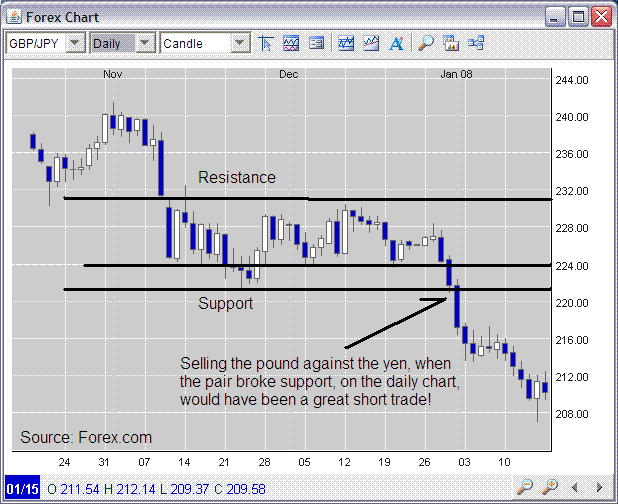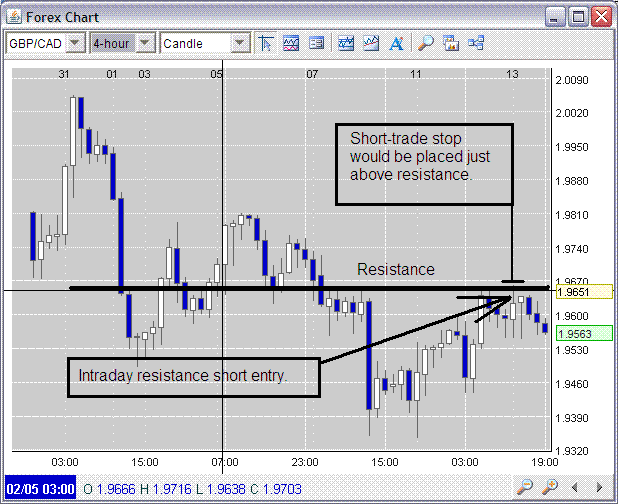Using Support and Resistance in Forex Trading
Many people disregard technical analysis as a hoax, and in some cases it can very well be. However, in Forex, technical analysis is a vital trading tool, as markets are “blind.” What’s a blind market? In a market where you cannot see the ‘tape’ and/or, order size, the market is considered ‘blind.’ In essence, you cannot see the order flow, or those actually making market, to see where the buying and selling is coming from.
When trading equities, many traders utilize Level II, or Level III quotes, which allow them to see order size coming from Electronic Communication Networks (ECNs – Think Island and Instinet). ECNs are electronic systems that match buying and selling orders anonymously, adding liquidity to equity markets. What’s more, on Level II and III quotes, traders can see other market makers (and their size) on both on the inside and outside bid and offer. Really, Level II and III allow traders to see the liquidity of the market. However, in Forex, retail traders do not have the ability to see bid and offer size, or who is willing to buy and sell.
Click here to learn how to utilize Bollinger Bands with a quantified, structured approach to increase your trading edges and secure greater gains with Trading with Bollinger Bands® – A Quantified Guide.
Moreover, in equities trading, the tape displays all transactions that occur, which can clue traders into order flow, by being able to see the actual prints roll by.
Retail traders (you and me!) can not see any of the above in Forex, and thus, are “blind” to order flow and size of buyers and sellers. When you submit an order in Forex, your broker will either pass the trade through to the market, or actually take the other side… Thus, you are blind to the market, other than the last print shown and the charts you are watching. All of this is exactly why technical analysis is so vital in Forex, as outside of economic and currency related news (and analysis), the really only other indicators traders have is technical analysis. In essence, Forex is one of the purest markets for technical analysis, because it is indeed, blind.
Support and Resistance
When utilizing technical analysis, it’s important to remember that most all technical indicators are lagging events – meaning they are simply conveying information about an event that has already occurred. However, through technical analysis, we hope to achieve two things:
- Understand what the broader investing public is thinking.
- Find reliable indicators that not only show us what has transpired, but give us some insight to what could take place in the future.
When we utilize technical analysis, the indicators become “self fulfilling prophecies”, meaning that enough people are watching – and acting on – the same information, so as to make an event occur.
Two key concepts in technical analysis are support and resistance:
Support: A certain price level that shows significant ability to hold the currency above. Support is generally thought of as a horizontal line drawn on a chart that coincides with multiple historical highs and lows, or significant price level, like a whole number.
Resistance: A certain price level that shows significant ability to hold the currency below. Support is generally thought of as a horizontal line drawn on a chart that coincides with multiple historical highs and lows, or significant price level, like a whole number.
There are other types of support and resistance, like ascending and descending, though we will not cover them here.
In Practice
Now that we have an understanding of why technical analysis is important, and what support and resistance are, lets apply the two to a chart and trading scenario.
The below daily chart shows recent trading of the pound versus yen. The pair had come off a decline, and began trading laterally for just over two months. During this time, traders would have been able to draw support and resistance lines, based on the highs and lows of the lateral trend… You can see how easy it is to draw support and resistance lines, as the chart visually shows us where the highs and lows are. Unless you are applying some sort of quant-related system to support and resistance, there’s really no need for any math. Support and resistance are really visual indications of market psychology. Through support and resistance we can see where the market may become jittery upon rising, or falling.
Traders attempting to find a longer-term hold, would have sought a break above or below support and resistance before taking positions, while those with shorter time frames (swing and intraday traders), would have most likely used the support and resistance lines as contrarian indicators (more on this in a moment.)
As the below chart shows, support and resistance were revealed as the pair traded laterally for over 60-days. Then, a technical event occurred that would have brought longer-term traders (investors, really) in off the fence. The pair broke below the 2.21 area, which was a breach of support. What’s more, support coincided with the 2.21 whole number (actual support was in the 2.2130 region). Whole numbers are generally harder to penetrate, mostly just in terms of market-psychology though.
When the GBP/JPY pair fell below two month support, traders who were long, most likely began selling, in an effort to cut losses. What’s more, those who did not have positions, likely began to pile into the pair short, adding supplemental pressure to the pound. In the end, short-side traders most likely profited handsomely.
(FYI, for those using support and resistance for stops, orders should be placed slightly below, or above support and resistance, respectively. It’s important to force the pair to actually breach support and resistance, before closing positions, otherwise we run the risk of being unnecessarily stopped out of our positions.)

Intraday and Swing Trader Contrarians
Intraday and swing traders can use support and resistance in the manor described in the above section, but can also use support and resistance as contrarian indicators as well. (It’s important to note that long-term traders can also use support and resistance as contrarian indicators, but perhaps will have a more difficult time finding profitable setups, especially if the stock is traveling laterally in a channel, or consolidating in a wedge.)
As the below 4-hour chart shows, the pound recently found intraday resistance in the 1.950 area, which it had tested twice in the past 20-hours, before the short-entry was derived. The chart is fairly self-explanatory in terms of the contrarian signal… Intraday and swing traders would have attempted to take short positions at, or near resistance. The trade would have most likely, been profitable.

IMPORTANT: If you look closely at the area where the signal was generated, you will see that the pair briefly broke above resistance, just slightly. This is known as a “head fake” and generally shakes out weak hands, rookies, or those who do not have a stop loss plan already in effect. Thus, to avoid falling victim to head fakes we can do one of two things (or both):
- Place stops at a level outside of support, or resistance, at a point large where we won’t be devastated if our stops are hit and…
- The stop should be at a level far enough outside of support, or resistance that will keep us from falling victim to a head fake, should the pair make a quick move outside support, or resistance and then retrace itself. One way of doing this not closing our position unless the chart-bar (4-hour in this case) closes outside of support, or resistance.
In short, though support and resistance are rather basic when it comes to technical analysis, they can be extremely effective for dexterous traders. And really, sometimes, keeping things simple is the best course of action anyway.
Mark Whistler is the founder of WallStreetRockStar.com and is the author of multiple books on trading.
Mark’s newest book, The Swing Trader’s Bible (John Wiley & Sons, Inc.) – co-authored with CNBC/Fox News regular guest Matt McCall – will be on shelves in late summer, 2008. In addition, Mark also writes regularly for TraderDaily.com and Investopedia.com.
